Spatial-Temporal Coupling Coordination Relationship between Urbanization and Green Development in the Coastal Cities of China
Abstract
1. Introduction
2. Literature Review
3. Materials and Methods
3.1. Study Area
3.2. Construction of Indicator System and Data Sources
3.3. Methods
3.3.1. Entropy Weight Method
3.3.2. Relative Development Model
3.3.3. Coupling and Coordination Model
3.3.4. Geographical Weighted Regression Model
3.4. Research Framework
4. Results
4.1. Spatial-Temporal Characteristics of Urbanization
4.2. Spatial-Temporal Characteristics of GD
4.3. Spatial-Temporal Relative Development Degree of Urbanization and GD
4.4. Spatial-Temporal Coordination Relationship between Urbanization and GD
4.5. Driving-Factors Analysis of Coordinating Development of Urbanization and GD
5. Discussion
6. Conclusions and Policy Implications
6.1. Conclusions
- (1)
- Both the degree of urbanization and GD of the coastal cities show an upward trend during the research period. The spatial characteristic of urbanization and GD had similar patterns, that municipalities and sub-provincial cities were on high level of urbanization and GD, while small prefecture-level cities were on the low levels. It can be concluded that the development of urbanization and GD is positively related with scales of land, population, economy, and other aspects.
- (2)
- The RDD of urbanization and GD significantly improved in big and medium cities, while small cities, most agglomerated in the northeast and southwest of the study area, are still in “low urbanization and GD” state. Moreover, the relationship of the two systems in these cities has not been seriously considered since the RDD showed insignificantly temporal characteristics, indicating that the development of these two systems has not been together planned. The CCD of urbanization and GD generally improved during the research period, transferring from moderate disorder to light disorder recession. Big cities, such as Shanghai, Shenzhen, and Guangzhou have entered coordinated development period, while small cities are still in maladjusted development period due to the low level of economic development, technical innovation, and industrial structure optimization. Cities with better performance of coordination between urbanization and GD proceeded faster in the improvement of the two systems, making the spatial gap larger.
- (3)
- During the research period, China’s economic structure optimization played an increasingly significant role in coordinating urbanization and green development of the coastal cities. Meanwhile, the optimal urbanization process was also an important driving force of the coordinated development of the two systems. However, the present level of ecological and environmental protection significantly restricted the coordination development between urbanization and GD. It can be concluded that the role played by technological innovation in improving the coordinated development of urbanization and GD is insignificant. For China and other developing countries, the achievement of economic growth under the condition of ecological protection is still one of the main targets in the future.
6.2. Policy Implications
Author Contributions
Funding
Institutional Review Board Statement
Informed Consent Statement
Data Availability Statement
Conflicts of Interest
References
- Henderson, V. The urbanization process and economic growth: The so-what question. J. Econ. Growth 2003, 8, 47–71. [Google Scholar] [CrossRef]
- Department of Economic and Social Affairs, Population Division. World Urbanization Prospects: The 2018 Revision; United Nations: New York, NY, USA, 2019. [Google Scholar]
- Zhou, Y.; Li, X.; Asrar, G.R.; Smith, S.J.; Imhoff, M. A global record of annual urban dynamics (1992–2013) from nighttime lights. Remote Sens. Environ. 2018, 219, 206–220. [Google Scholar] [CrossRef]
- Zhai, X.; Reed, R.; Mills, A. Embracing off-site innovation in construction in China to enhance a sustainable built environment in urban housing. Int. J. Constr. Manag. 2014, 14, 123–133. [Google Scholar] [CrossRef]
- China National Bureau of Statistics. China Statistical Yearbook 2017; China Statistics Press: Beijing, China, 2017. [Google Scholar]
- Chen, M.; Liu, W.; Lu, D. Challenges and the way forward in China’s new-type urbanization. Land Use Policy 2016, 55, 334–339. [Google Scholar] [CrossRef]
- He, J.; Wan, Y.; Feng, L.; Ai, J.; Wang, Y. An integrated data envelopment analysis and emergy-based ecological footprint methodology in evaluating sustainable development, a case study of Jiangsu Province, China. Ecol. Indic. 2016, 70, 23–34. [Google Scholar] [CrossRef]
- Yu, B. Ecological effects of new-type urbanization in China. Renew. Sust. Energy Rev. 2021, 135, 110239. [Google Scholar] [CrossRef]
- Zhu, Y.G. Environmental impacts of rapid urbanization in China: A showcase of recent research developments. Environ. Sci. Pollut. Res. 2012, 19, 1351. [Google Scholar] [CrossRef]
- Fang, C.; Liu, X. Temporal and spatial differences and imbalance of China’s urbanization development during 1950–2006. Acta Geogr. Sin. 2009, 19, 719–732. [Google Scholar] [CrossRef]
- Song, M.; Wang, S. Measuring Environment-Biased Technological Progress Considering Energy Saving and Emission Reduction. Process Saf. Environ. Prot. 2018, 116, 745–753. [Google Scholar] [CrossRef]
- Brand, U. Green economy—The next oxymoron? No lessons learned from failures of implementing sustainable development. GAIA Ecol. Perspect. Sci. Soc. 2012, 21, 28–32. [Google Scholar] [CrossRef]
- D’Amato, D.; Droste, N.; Allen, B. Green, circular, bio economy:A comparative analysis of sustainability avenues. J. Clean. Prod. 2017, 168, 716–734. [Google Scholar] [CrossRef]
- Mundaca, L.; Neij, L.; Markandya, A. Towards a green energy economy? Assessing policy choices, strategies and transitional pathways. Appl. Energy 2016, 179, 1283–1292. [Google Scholar] [CrossRef]
- UNEP. Towards a Green Economy: Pathways to Sustainable Development and Poverty Eradication; A Synthesis for Policy Makers; UNEP: Nairobi, Kenya, 2011. [Google Scholar]
- OECD. Towards Green Growth; OECD Publishing: Paris, France, 2011. [Google Scholar]
- Luukkanen, J.; Kaivo-oja, J.; Vähäkari, N.; O’Mahony, T.; Korkeakoski, M.; Panula-Ontto, J.; Hogarth, N. Green economic development in Lao PDR: A sustainability window analysis of Green Growth Productivity and the Effificiency Gap. J. Clean. Prod. 2019, 211, 818–829. [Google Scholar] [CrossRef]
- World Bank. Inclusive Green Growth: The Pathway to Sustainable Development; World Bank: Washington, DC, USA, 2012. [Google Scholar]
- Hu, A.G.; Zhou, S.J. Green development: Functional definition, mechanism analysis and development strategy. China Popul. Resour. Environ. 2014, 24, 14–20. [Google Scholar]
- Huang, M.; Ye, Q. The Marxist green development concept and green development in contemporary China: Comment on incompatibility theory between environment and development. Econ. Res. J. 2017, 52, 17–30. [Google Scholar]
- Wang, M.X.; Zhao, H.H.; Cui, J.X.; Fan, D.; Lv, B.; Wang, G.; Li, Z.H.; Zhou, G.J. Evaluating green development level of nine cities within the Pearl River Delta. China. J. Clean. Prod. 2017, 174, 315–323. [Google Scholar] [CrossRef]
- Wang, Z.B.; Wang, X.M.; Liang, L.W. Green economic effificiency in the Yangtze River Delta: Spatiotemporal evolution and inflfluencing factors. Ecosyst. Health Sustain. 2019, 5, 20–35. [Google Scholar] [CrossRef]
- Wang, S.J.; Ma, H.; Zhao, Y.B. Exploring the relationship between urbanization and the eco-environment—A case study of Beijing–Tianjin–Hebei region. Ecol. Indic. 2014, 45, 171–183. [Google Scholar] [CrossRef]
- Feng, Y.; Dong, X.; Zhao, X.; Zhu, A. Evaluation of urban green development transformation process for Chinese cities during 2005–2016. J. Clean. Prod. 2020, 266, 121707. [Google Scholar] [CrossRef]
- Costanza, R.; Daly, L.; Fioramonti, L. Modelling and measuring sustainable wellbeing in connection with the UN sustainable development goals. Ecol. Econ. 2016, 130, 350–355. [Google Scholar] [CrossRef]
- Li, F.; Liu, X.S.; Hu, D.; Wang, R.S. Evaluation method and its application for urban sustainable development. Acta Ecol. Sin. 2007, 27, 4793–4802. [Google Scholar]
- Zheng, B.; Bedra, K.B. Recent Sustainability Performance in China: Strength-Weakness Analysis and Ranking ofProvincial Cities. Sustainability 2018, 10, 3063. [Google Scholar] [CrossRef]
- Wang, Q.; Yuan, X.; Zhang, J.; Gao, Y.; Hong, J.; Zuo, J.; Liu, W. Assessment of the Sustainable Development Capacity with the Entropy Weight Coefficient Method. Sustainability 2015, 7, 13542–13563. [Google Scholar] [CrossRef]
- Cyril, S.; Oldroyd, J.C.; Renzaho, A. Urbanisation, urbanicity, and health: A systematic review of the reliability and validity of urbanicity scales. BMC Public Health 2013, 13, 513. [Google Scholar] [CrossRef] [PubMed]
- United Nations Department of Economic and Social Affairs Population Division. World Urbanization Prospects: The 2014 Revision; UNDESA: New York, NY, USA, 2015. [Google Scholar]
- Herzele, A.V.; Wiedemann, T. A monitoring tool for the provision of accessible and attractive urban green spaces. Landsc. Urban Plan. 2003, 63, 109–126. [Google Scholar] [CrossRef]
- Savard, J.-P.L.; Clergeau, P.; Mennechez, G. Biodiversity concepts and urban ecosystems. Landsc. Urban Plan. 2000, 48, 131–142. [Google Scholar] [CrossRef]
- Sharifi, A. From Garden City to Eco-Urbanism:The Quest for Sustainable Neighborhood Development. Sustain. Cities Soc. 2016, 20, 1–16. [Google Scholar] [CrossRef]
- Turvey, R.A. Researching Green Development and Sustainable Communities in Small Urban Municipalities. Int. J. Syst. Sci. 2015, 7, 68–86. [Google Scholar] [CrossRef]
- Zaidman, M.; Kark, R. Garden Cities in the Jewish Yishuv of Palestine:Zionist Ideology and Practice 1905–1945. Plan. Perspect. 2016, 31, 55–82. [Google Scholar] [CrossRef]
- Ghorab, H.K.E.; Shalaby, H.A. Eco and Green cities as new approaches for planning and developing cities in Egypt. Alex. Eng. J. 2016, 55, 495–503. [Google Scholar] [CrossRef]
- Bakirtas, T.; Akpolat, A.G. The relationship between energy consumption, urbanization, and economic growth in new emerging-market countries. Energy 2018, 147, 110–121. [Google Scholar] [CrossRef]
- Black, D.; Henderson, V. A Theory of Urban Growth. J. Polit. Econ. 1999, 107, 252–284. [Google Scholar] [CrossRef]
- Spence, M.; Annez, P.C.; Buckley, R.M. Urbanization and Growth; World Bank Publications: Washington, DC, USA, 2009. [Google Scholar]
- Dyson, T. The Role of the Demographic Transition in the Process of Urbanization. Popul. Dev. Rev. 2011, 37, 34–54. [Google Scholar] [CrossRef]
- Deng, X.; Huang, J.; Rozelle, S.; Uchida, E. Economic Growth and the Expansion of Urban Land in China. Urban Stud. 2010, 47, 813–843. [Google Scholar] [CrossRef]
- Zinia, N.J.; Mcshane, P. Ecosystem services management: An evaluation of green adaptations for urban development in Dhaka, Bangladesh. Landsc. Urban Plan. 2018, 173, 23–32. [Google Scholar] [CrossRef]
- Rashid, A.; Irum, A.; Malik, I.A.; Ashraf, A.; Liu, R.; Liu, G.; Ullah, H.; Ali, M.U.; Yousaf, B. Ecological footprint of Rawalpindi; Pakistan’s fifirst footprint analysis from urbanization perspective. J. Clean. Prod. 2017, 170, 362–368. [Google Scholar] [CrossRef]
- Song, W.; Deng, X.; Liu, B.; Li, Z.; Jin, G. Impacts of Grain-for-Green and Grain-for-Blue Policies on Valued Ecosystem Services in Shandong Province, China. Adv. Meteorol. 2015, 2015, 213534. [Google Scholar] [CrossRef]
- Bai, Y.; Deng, X.; Jiang, S.; Zhang, Q.; Wang, Z. Exploring the relationship between urbanization and urban eco-efficiency: Evidence from prefecture-level cities in China. J. Clean. Prod. 2017, 195, 1487–1496. [Google Scholar] [CrossRef]
- Liu, H.; Fang, C.; Li, Y. The Coupled Human and Natural Cube: A conceptual framework for analyzing urbanization and eco-environment interactions. Acta Geogr. Sin. 2019, 74, 1489–1507. [Google Scholar]
- Tian, Y.; Zhou, D.; Jiang, G. Conflict or Coordination? Multiscale assessment of the spatio-temporal coupling relationship between urbanization and ecosystem services: The case of the Jingjinji Region, China. Ecol. Indic. 2020, 117, 106543. [Google Scholar] [CrossRef]
- Zhou, L.; Che, L.; Sun, D. The Coupling Coordination Development between Urbanization and Economic Growth and Its Influencing Factors in China. Econ. Geogr. 2019, 39, 97–107. [Google Scholar]
- Xu, D.; Hou, G. The Spatiotemporal Coupling Characteristics of Regional Urbanization and Its Influencing Factors: Taking the Yangtze River Delta as an Example. Sustainability 2019, 11, 822. [Google Scholar] [CrossRef]
- Zhang, K.; Shen, J.; He, R.; Fan, B.; Han, H. Dynamic Analysis of the Coupling Coordination Relationship between Urbanization and Water Resource Security and Its Obstacle Factor. Int. J. Environ. Res. Public Health 2019, 16, 4765. [Google Scholar] [CrossRef]
- Liu, F.; Liu, C. Regional disparity, spatial spillover effects of urbanisation and carbon emissions in China. J. Clean. Prod. 2019, 241, 118226. [Google Scholar] [CrossRef]
- Yuan, H.; Zhang, T.; Feng, Y.; Liu, Y.; Ye, X. Does financial agglomeration promote the green development in China? A spatial spillover perspective. J. Clean. Prod. 2019, 237, 117808. [Google Scholar] [CrossRef]
- Duan, P.; Liu, S.; Peng, Y.; Zhang, H. Spatial-Temporal Coupling Coordination Relationship Between Development Strength and Resource Environmental Bearing Capacity of Coastal Cities in China. Econ. Geogr. 2018, 38, 60–67. [Google Scholar]
- Seto, K.C.; Güneralp, B.; Hutyra, L.R. Global forecasts of urban expansion to 2030 and direct impacts on biodiversity and carbon pools. Proc. Natl. Acad. Sci. USA 2012, 109, 16083–16088. [Google Scholar] [CrossRef]
- Luo, Y. Sustainability Associated Coastal Eco-environmental Problems and Coastal Science Development in China. Bull. Chin. Acad. Sci. 2016, 31, 1133–1142. [Google Scholar]
- Zheng, Z.; Wu, Z.; Chen, Y.; Yang, Z.; Marinello, F. Exploration of eco-environment and urbanization changes in coastal zones: A case study in China over the past 20 years. Ecol. Indic. 2020, 119, 106847. [Google Scholar] [CrossRef]
- Zhou, D.; Tian, Y.; Jiang, G. Spatio-temporal investigation of the interactive relationship between urbanization and ecosystem services: Case study of the Jingjinji urban agglomeration, China. Ecol. Indic. 2018, 95, 152–164. [Google Scholar] [CrossRef]
- Zhao, Y.; Wang, S.; Zhou, C. Understanding the relation between urbanization and the eco-environment in China’s Yangtze River Delta using an improved EKC model and coupling analysis. Sci. Total Environ. 2016, 571, 862–875. [Google Scholar] [CrossRef]
- Kim, S.E.; Kim, H.; Chae, Y. A new approach to measuring green growth: Application to the OECD and Korea. Futures 2014, 63, 37–48. [Google Scholar] [CrossRef]
- Cheng, X.; Long, R.; Chen, H.; Li, W. Green competitiveness evaluation of provinces in China based on correlation analysis and fuzzy rough set. Ecol. Indic. 2018, 85, 841–852. [Google Scholar] [CrossRef]
- Bartelmus, P. The future we want: Green growth or sustainable development? Environ. Dev. 2013, 7, 165–170. [Google Scholar] [CrossRef]
- Zhang, X.; Wang, C.; Li, E.; Xu, C. Assessment model of eco-environmental vulnerability based on improved entropy weight method. Sci. World J. 2014, 2014, 797814. [Google Scholar]
- Cai, J.; Li, X.; Liu, L.; Chen, Y.; Wang, X.; Lu, S. Coupling and coordinated development of new urbanization and agro-ecological environment in China. Sci. Total Environ. 2021, 776, 145837. [Google Scholar] [CrossRef]
- Solymar, L.; Webb, D.J.; Grunnet-Jepsen, A. The Physics and Applications of Photorefractive Materials; Clarendon Press: Wotton-under-Edge, UK, 1996; Volume 11. [Google Scholar]
- Ariken, M.; Zhang, F.; Chan, N.w.; Kung, H.-t. Coupling coordination analysis and spatio-temporal heterogeneity between urbanization and eco-environment along the Silk Road Economic Belt in China. Ecol. Indic. 2021, 121, 107014. [Google Scholar] [CrossRef]
- Liu, W.; Jiao, F.; Ren, L.; Xu, X.; Wang, J.; Wang, X. Coupling coordination relationship between urbanization and atmospheric environment security in Jinan City. J. Clean. Prod. 2018, 204, 1–11. [Google Scholar] [CrossRef]
- Wang, J.; Wang, S.; Li, S.; Feng, K. Coupling analysis of urbanization and energy-environment efficiency: Evidence from Guangdong province. Appl. Energy 2019, 254, 113650. [Google Scholar] [CrossRef]
- Gan, L.; Shi, H.; Hu, Y.; Lev, B.; Lan, H. Coupling coordination degree for urbanization city-industry integration level: Sichuan case. Sustain. Cities Soc. 2020, 58, 102136. [Google Scholar] [CrossRef]
- Lv, T.; Wang, L.; Zhang, X.; Xie, H.; Lu, H.; Li, H.; Liu, W.; Zhang, Y. Coupling Coordinated Development and Exploring Its Influencing Factors in Nanchang, China: From the Perspectives of Land Urbanization and Population Urbanization. Land 2019, 8, 178. [Google Scholar] [CrossRef]
- Verma, P.; Raghubanshi, A.S. Urban sustainability indicators: Challenges and opportunities. Ecol. Indic. 2018, 93, 282–291. [Google Scholar] [CrossRef]
- Brunsdon, C.; Fotheringham, S.; Charlton, M. Geographically Weighted Regression. J. R. Stat. Soc. 1998, 47, 431–443. [Google Scholar] [CrossRef]
- Bian, H.; Gao, J.; Wu, J.; Sun, X.; Du, Y. Hierarchical analysis of landscape urbanization and its impacts on regional sustainability: A case study of the Yangtze River Economic Belt of China. J. Clean. Prod. 2021, 279, 123267. [Google Scholar] [CrossRef]
- Li, M.; He, B.; Guo, R.; Li, Y.; Chen, Y.; Fan, Y. Study on Population Distribution Pattern at the County Level of China. Sustainability 2018, 10, 3598. [Google Scholar] [CrossRef]
- Ke, S.; Yao, Z. Industrial Structure, City Size and Urban Productivity in China. Econ. Res. J. 2014, 49, 76–88. [Google Scholar]
- Huang, Y.; Li, L. A comprehensive assessment of green development and its spatial-temporal evolution in urban agglomerations of China. Geogr. Res. 2017, 36, 1309–1322. [Google Scholar]
- Alam, S.; Fatima, A.; Butt, M.S. Sustainable development in Pakistan in the context of energy consumption demand and environmental degradation. J. Asian Econ. 2007, 18, 825–837. [Google Scholar] [CrossRef]
- Clark, L.P.; Millet, D.B.; Marshall, J.D. Air quality and urban form in U.S. urban areas: Evidence from regulatory monitors. Environ. Sci. Technol. 2011, 45, 7028–7035. [Google Scholar] [CrossRef]
- Zeng, C.; Song, Y.; Cai, D.; Hu, P.; Cui, H.; Yang, J.; Zhang, H. Exploration on the spatial spillover effect of infrastructure network on urbanization: A case study in Wuhan urban agglomeration. Sustain. Cities Soc. 2019, 47, 101476. [Google Scholar] [CrossRef]
- Miao, W.A.; Chao, F.B. The win-win ability of environmental protection and economic development during China’s transition. Technol. Forecast. Soc. Chang. 2021, 166, 120617. [Google Scholar]
- Wang, K.-H.; Umar, M.; Akram, R.; Caglar, E. Is technological innovation making world “Greener”? An evidence from changing growth story of China. Technol. Forecast. Soc. Chang. 2021, 165, 120516. [Google Scholar] [CrossRef]
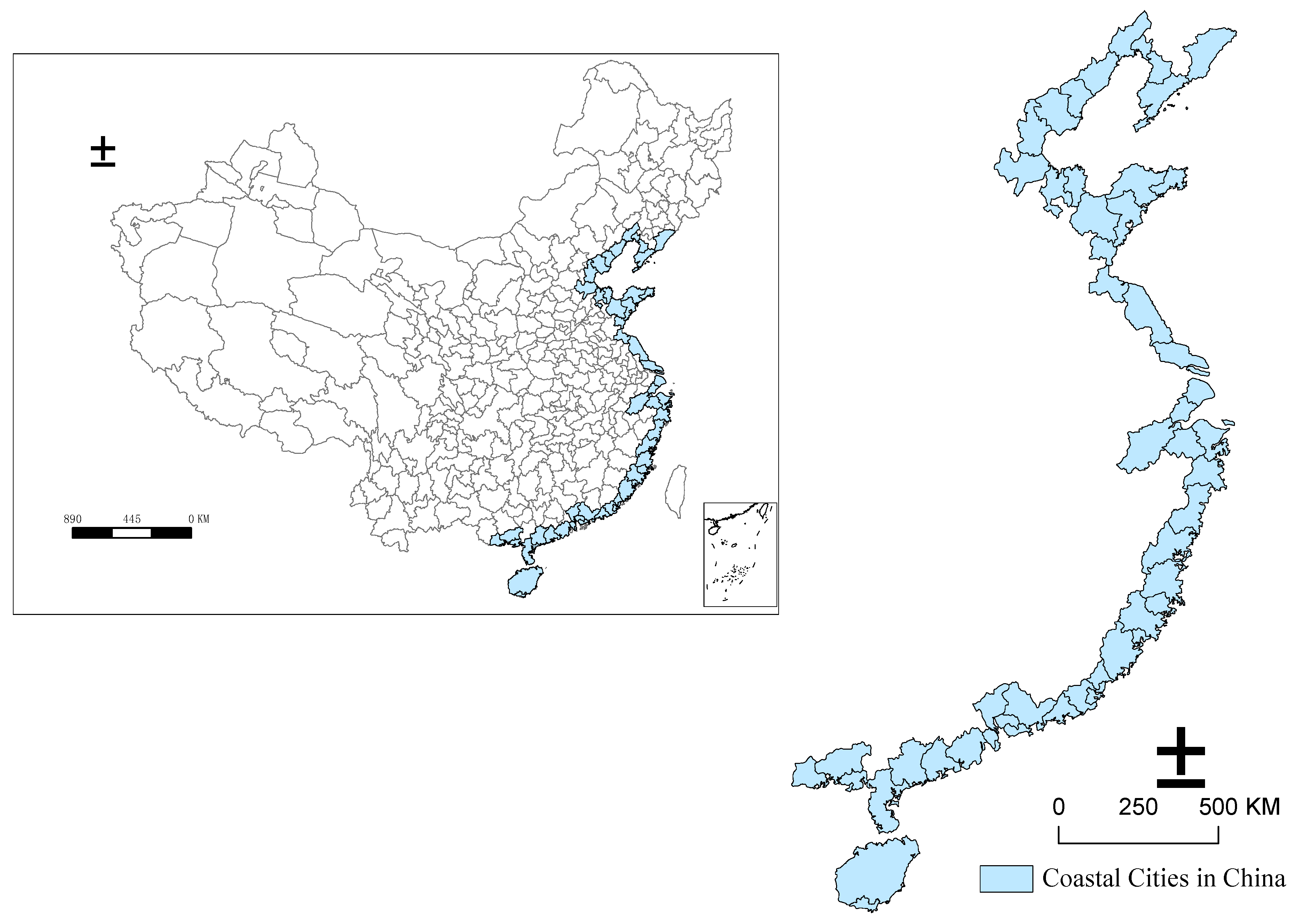
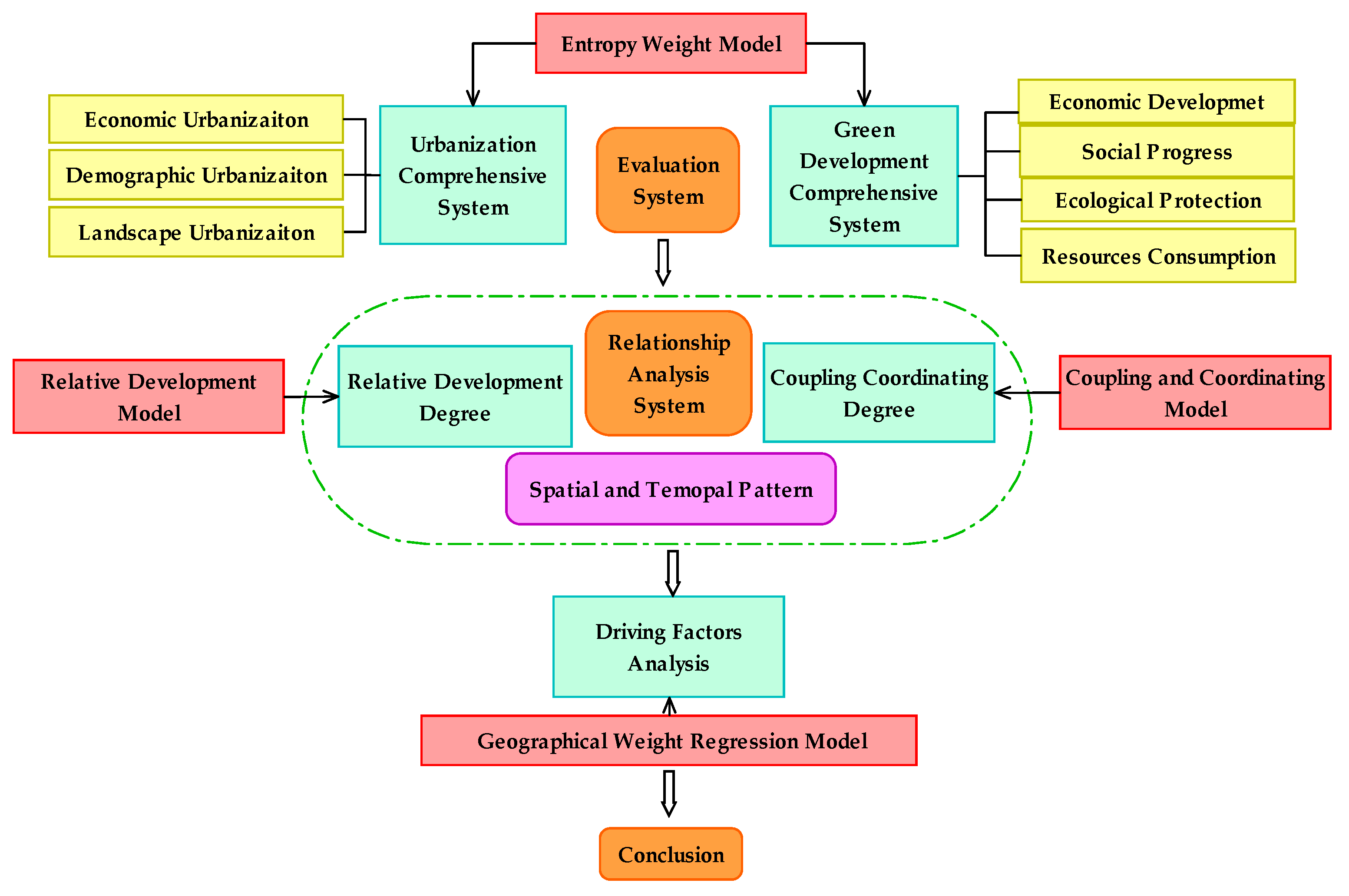
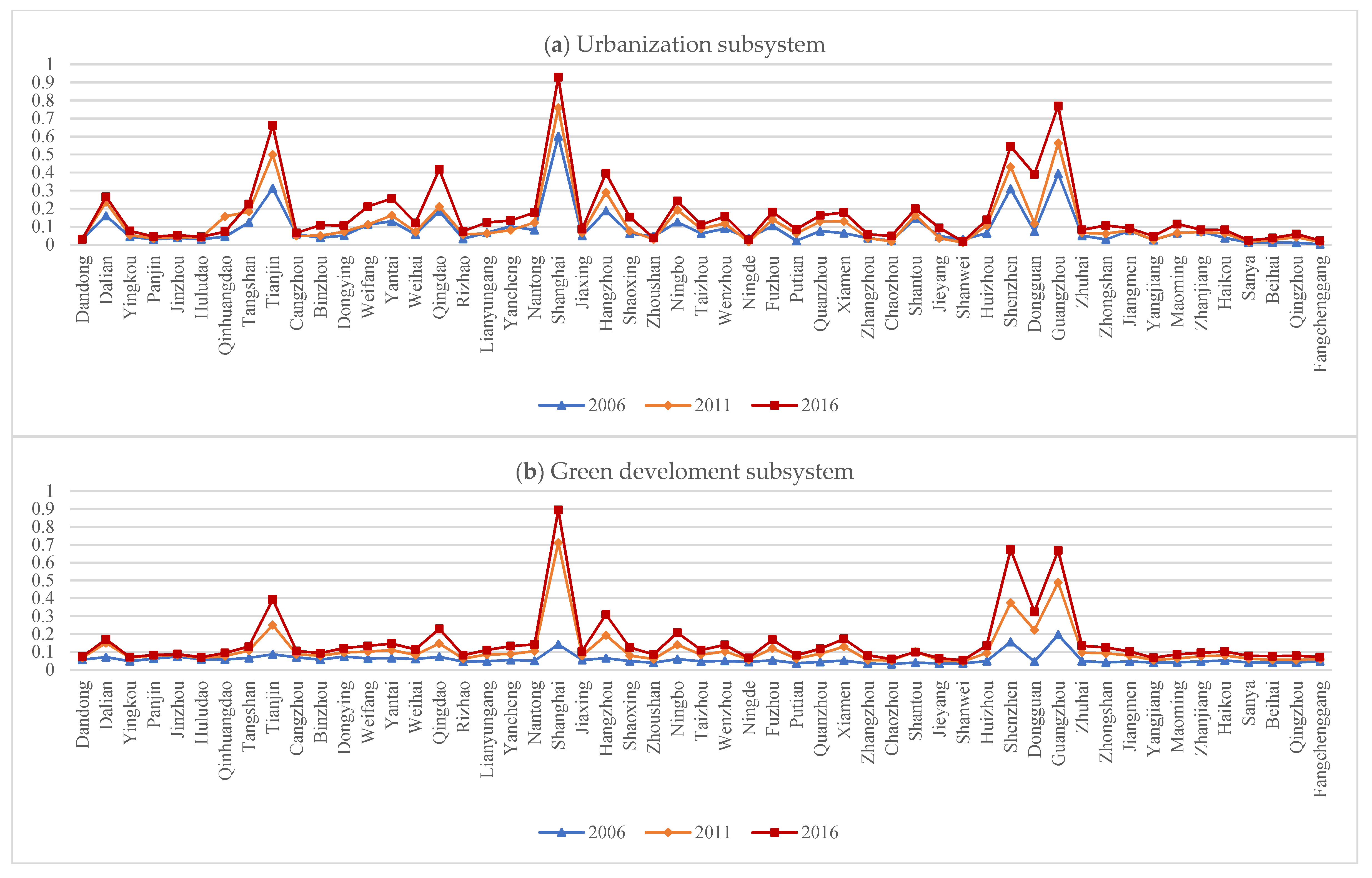
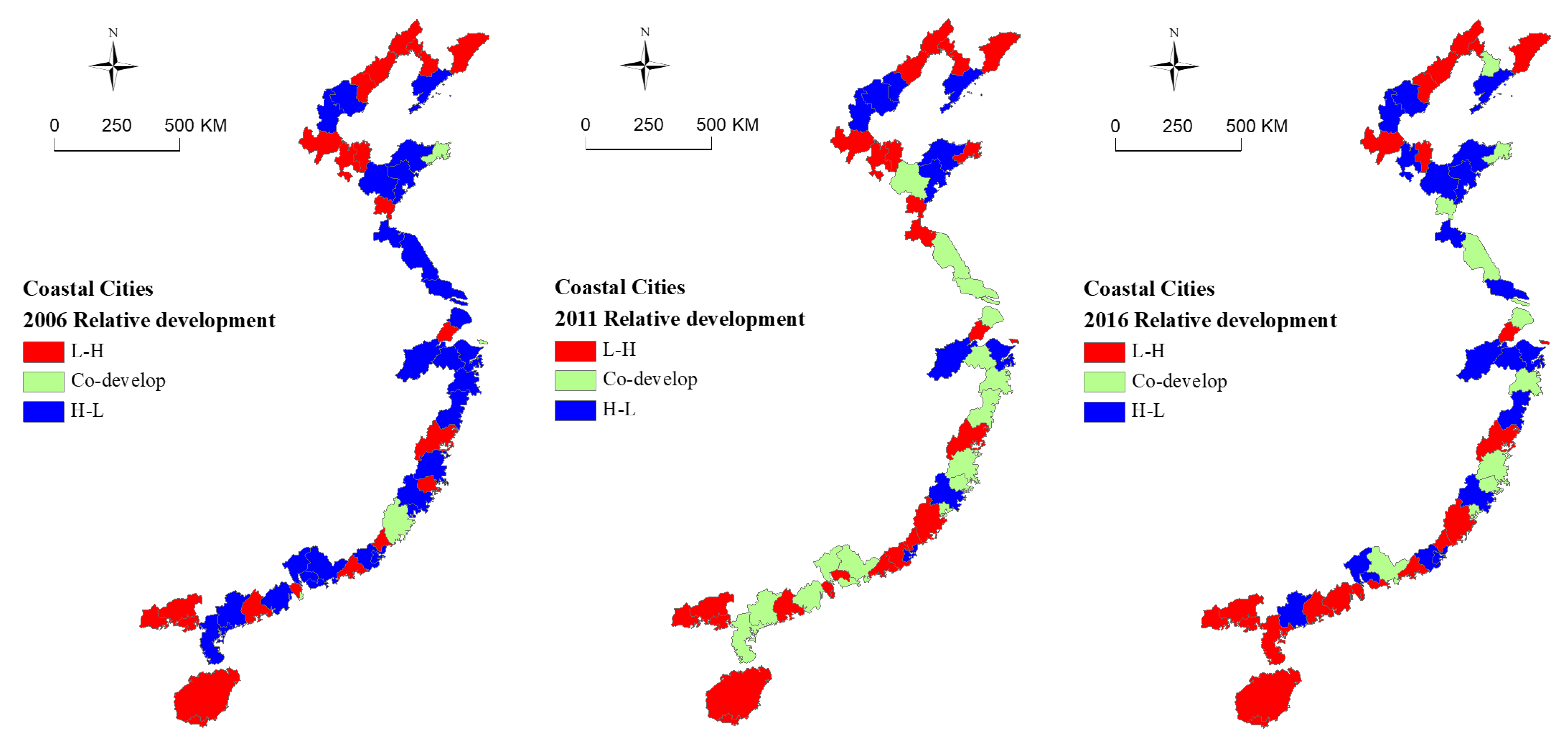
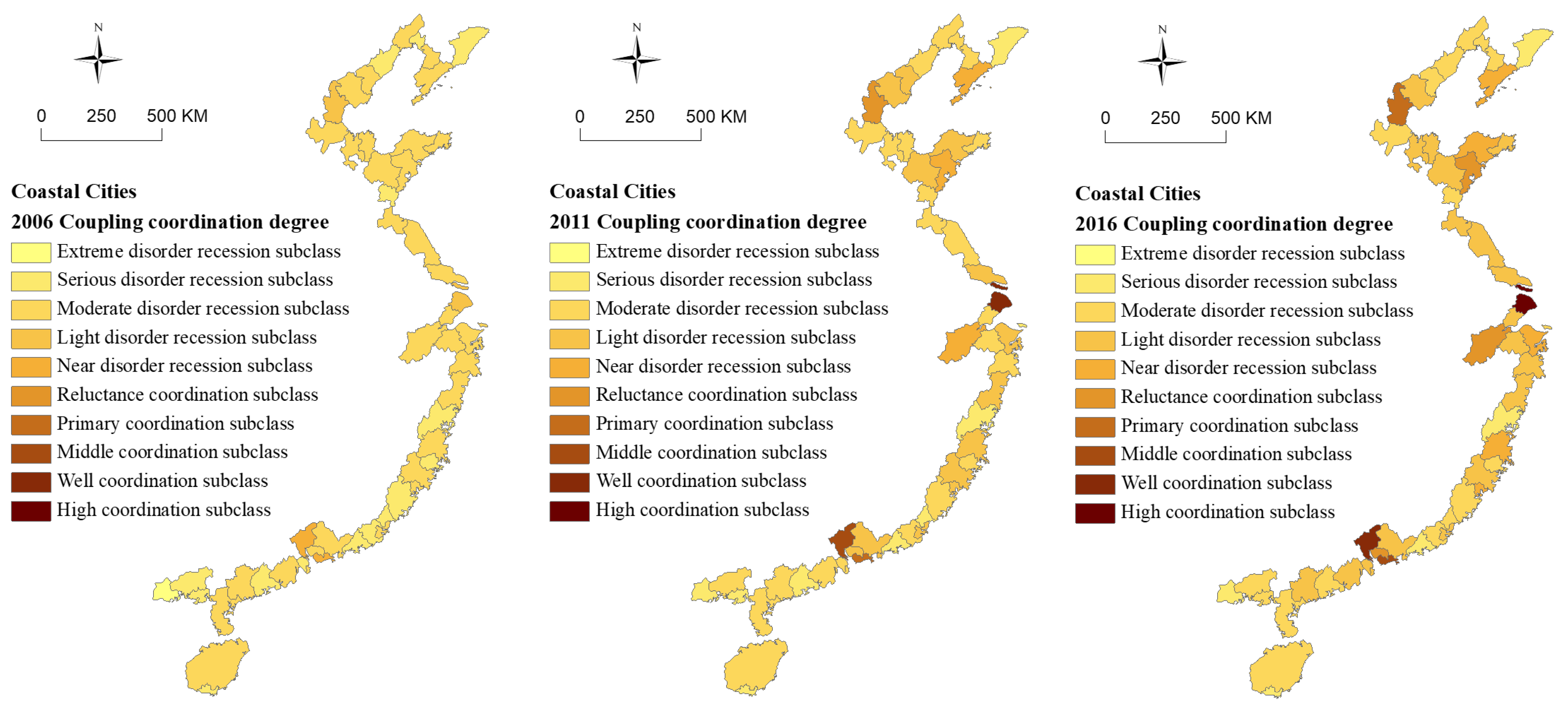
| System Layer | Standard Layer | Indicator Layer | Weight | Indicator Direction |
|---|---|---|---|---|
| Urbanization system | Economic urbanization (U1) | Nonagricultural output (10,000,000 yuan) (x1) | 0.368 | + |
| Demographic urbanization (U2) | Nonagricultural population (10,000 persons) (x2) | 0.283 | + | |
| Landscape urbanization (U3) | Urban built-up area (hectare) (x3) | 0.349 | + | |
| Green development system | Economic development (G1) | Per capital GDP (yuan) (x4) | 0.036 | + |
| Third production ratio (%) (x5) | 0.010 | + | ||
| Expenditure for science and technology (10,000 yuan) (x6) | 0.241 | + | ||
| Social progress (G2) | Expenditure for education (10,000 yuan) (x7) | 0.098 | + | |
| Number of beds in medical and health institutions (unit) (x8) | 0.055 | + | ||
| Disposable income ratio of urban and rural population (%) (x9) | 0.012 | + | ||
| Ecological protection (G3) | Industrial wastewater discharge (10,000 tons) (x10) | 0.009 | − | |
| Industrial SO2 emissions (tons) (x11) | 0.009 | − | ||
| Green area (hectare) (x12) | 0.157 | + | ||
| Resource consumption (G4) | Per capita cultivated land area (hm2/person) (x13) | 0.033 | − | |
| Per capita water resources (m3/person) (x14) | 0.179 | − | ||
| Per capita electricity consumption resources (kw h/person) (x15) | 0.160 | − |
| β-Value | Meaning | Classification |
|---|---|---|
| 0.00–0.90 | The urbanization lags behind GD | L-H |
| 0.90–1.20 | Simultaneous development | Co-development |
| 1.10–+∞ | The GD lags behind urbanization | H-L |
| Class | D-Value | Subclass |
|---|---|---|
| Maladjustment | 0.000–0.100 | Extreme disorder recession |
| 0.101–0.200 | Serious disorder recession | |
| 0.201–0.300 | Moderate disorder recession | |
| 0.301–0.400 | Light disorder recession | |
| Transition | 0.401–0.500 | Near disorder recession |
| 0.501–0.600 | Reluctance coordination | |
| Coordinated development | 0.601–0.700 | Primary coordination |
| 0.701–0.800 | Middle coordination | |
| 0.801–0.900 | Well coordination | |
| 0.901–1.000 | High coordination |
| Year | U1 | U2 | U3 | Urbanization | G1 | G2 | G3 | G4 | GD |
|---|---|---|---|---|---|---|---|---|---|
| 2006 | 0.018 | 0.035 | 0.036 | 0.090 | 0.009 | 0.014 | 0.023 | 0.012 | 0.059 |
| 2011 | 0.041 | 0.033 | 0.048 | 0.121 | 0.023 | 0.023 | 0.029 | 0.043 | 0.117 |
| 2016 | 0.057 | 0.046 | 0.068 | 0.170 | 0.039 | 0.032 | 0.034 | 0.053 | 0.158 |
| Year | Variable | Minimum (×10−6) | Maximum (×10−6) | Mean (×10−6) | Median (×10−6) | Standard Deviation (×10−6) | AICc | R2 | R2 Adjusted |
|---|---|---|---|---|---|---|---|---|---|
| 2006 | EDL | 0.367 | 0.964 | 0.619 | 0.468 | 0.246 | −196.827 | 0.811 | 0.772 |
| IDL | −294.495 | 306.412 | −5.565 | −142.673 | 219.570 | ||||
| TDL | −0.836 | −0.314 | −0.488 | −0.343 | 0.193 | ||||
| EEP | −0.468 | 0.771 | 0.313 | 0.598 | 0.456 | ||||
| URB | −238.860 | 427.438 | 303.292 | 256.167 | 68.519 | ||||
| 2011 | EDL | 0.322 | 0.489 | 0.431 | 0.429 | 0.047 | −176.342 | 0.939 | 0.926 |
| IDL | 289.358 | 2264.551 | 1390.424 | 1902.953 | 714.321 | ||||
| TDL | 0.084 | 0.101 | 0.093 | 0.096 | 0.005 | ||||
| EEP | −0.625 | 0.391 | −0.063 | −0.159 | 0.306 | ||||
| URB | 394.933 | 516.436 | 464.303 | 486.581 | 47.856 | ||||
| 2016 | EDL | 0.052 | 0.564 | 0.314 | 0.225 | 0.182 | −174.694 | 0.953 | 0.944 |
| IDL | 218.002 | 3305.081 | 1268.274 | 1140.858 | 764.061 | ||||
| TDL | 0.050 | 0.066 | 0.059 | 0.063 | 0.005 | ||||
| EEP | −0.913 | 0.644 | −0.215 | −0.378 | 0.616 | ||||
| URB | 354.996 | 536.691 | 438.178 | 420.601 | 69.372 |
Publisher’s Note: MDPI stays neutral with regard to jurisdictional claims in published maps and institutional affiliations. |
© 2021 by the authors. Licensee MDPI, Basel, Switzerland. This article is an open access article distributed under the terms and conditions of the Creative Commons Attribution (CC BY) license (https://creativecommons.org/licenses/by/4.0/).
Share and Cite
Shang, Y.; Liu, S. Spatial-Temporal Coupling Coordination Relationship between Urbanization and Green Development in the Coastal Cities of China. Sustainability 2021, 13, 5339. https://doi.org/10.3390/su13105339
Shang Y, Liu S. Spatial-Temporal Coupling Coordination Relationship between Urbanization and Green Development in the Coastal Cities of China. Sustainability. 2021; 13(10):5339. https://doi.org/10.3390/su13105339
Chicago/Turabian StyleShang, Yingshi, and Shuguang Liu. 2021. "Spatial-Temporal Coupling Coordination Relationship between Urbanization and Green Development in the Coastal Cities of China" Sustainability 13, no. 10: 5339. https://doi.org/10.3390/su13105339
APA StyleShang, Y., & Liu, S. (2021). Spatial-Temporal Coupling Coordination Relationship between Urbanization and Green Development in the Coastal Cities of China. Sustainability, 13(10), 5339. https://doi.org/10.3390/su13105339





